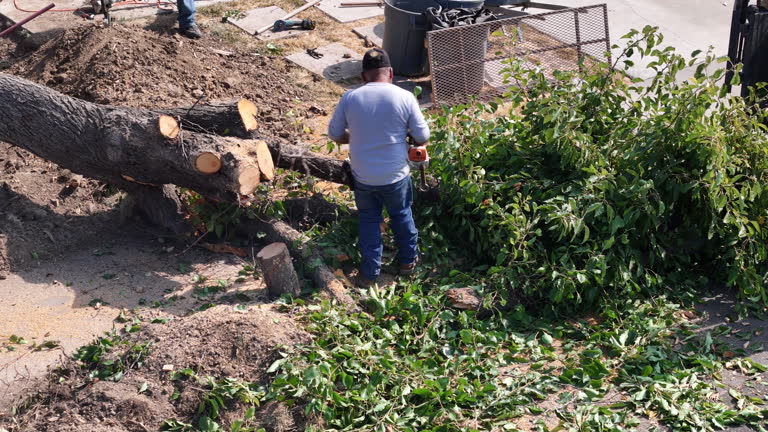Welcome to the fascinating world of tree service companies – an industry that goes far beyond the simple cutting and trimming of trees.
These companies are the unsung heroes of our urban and rural landscapes, assessing tree health, managing pests and diseases, maintaining the structural integrity of our green giants, and even providing emergency response services.
With a vast array of services that touch every aspect of tree care and management, there is so much more to discover and appreciate.
Join us as we delve deeper into this intriguing world that is often overlooked, yet plays an indispensable role in our environment.
(h2) Comprehensive Tree Health Assessment
Trees are more than just beautiful additions to our landscapes; they are vital components of our ecosystem.
They provide shade, clean the air, and support biodiversity.
To ensure these benefits continue for generations, it’s crucial to prioritize tree health.
(h3) Why Tree Health Assessments Matter
A comprehensive tree health assessment is akin to a yearly check-up for your tree.
It involves a thorough examination of the tree’s structure, roots, bark, foliage, and soil conditions.
This detailed evaluation helps identify potential problems early on, allowing for timely intervention and preventing serious issues.
(h3) Common Signs of Tree Distress
- Changes in Foliage: Discoloration, thinning, or premature leaf drop can indicate stress or disease.
- Unusual Bark: Cracks, cankers, or excessive peeling can be signs of damage or infection.
- Dying Branches: Dead or dying branches are a clear indication of a problem.
- Root Issues: Exposed roots, root rot, or girdling roots can compromise the tree’s stability.
- Insect Infestations: Visible signs of insect damage, such as holes in leaves or bark, can weaken the tree.
- Fungal Growth: Mushrooms or fungal fruiting bodies growing on or around the tree can be a sign of decay.
(h3) Tips for Maintaining Healthy Trees
- Regular Inspections: Conduct regular visual inspections of your trees to identify any issues early on.
- Proper Watering: Water your trees deeply and infrequently, especially during dry periods.
- Fertilization: Apply a balanced fertilizer to provide essential nutrients.
- Pruning: Prune trees to remove dead, diseased, or damaged branches.
- Mulching: Apply a layer of mulch around the base of the tree to conserve moisture and suppress weeds.
- Pest and Disease Control: Monitor for pests and diseases and take appropriate control measures.
- Professional Tree Care: Consult with a certified arborist for expert advice and care.
By investing in regular tree health assessments and following these tips, you can ensure the long-term health and vitality of your trees.
A healthy tree is a beautiful tree, and a beautiful tree is a valuable asset to any property.
(h2) Pest Management and Disease Control
Trees are magnificent organisms that contribute significantly to our environment.
However, they are susceptible to various pests and diseases that can compromise their health and vitality.
To ensure the longevity and beauty of your trees, it’s crucial to implement effective pest management and disease control strategies.
(h3) Common Tree Pests and Diseases
A myriad of pests and diseases can afflict trees. Some of the most common include:
(h3) Pests:
- Insects:
- Aphids: These tiny, sap-sucking insects can weaken trees and transmit diseases.
- Scale Insects: These armored pests attach themselves to branches and leaves, hindering growth and causing disfigurement.
- Borers: The larvae of various beetles, borers tunnel into tree trunks and branches, weakening the tree’s structure.
- Mites:
- Spider Mites: These microscopic arachnids can cause significant damage to leaves, resulting in yellowing and browning.
- Rodents:
- Gophers and Voles: These rodents can damage tree roots, leading to instability and decline.
(h3) Diseases:
- Fungal Diseases:
- Dutch Elm Disease: This fatal disease, caused by a fungus, affects elm trees.
- Oak Wilt: This fungal disease can rapidly kill oak trees.
- Powdery Mildew: This fungal disease causes a white, powdery coating on leaves, hindering photosynthesis.
- Bacterial Diseases:
- Fire Blight: This bacterial disease affects apple, pear, and other fruit trees, causing blackened and distorted leaves and branches.
(h3) Integrated Pest Management (IPM)
Integrated Pest Management (IPM) is a comprehensive approach to pest control that combines various strategies to minimize pest damage while preserving the environment.
Key components of IPM include:
- Monitoring: Regularly inspect your trees for signs of pest or disease infestation.
- Cultural Controls: Implement practices like proper watering, fertilization, and pruning to promote tree health.
- Biological Control: Utilize natural enemies, such as predatory insects and beneficial nematodes, to control pests.
- Chemical Control: Apply pesticides as a last resort and only when necessary, using targeted treatments to minimize environmental impact.
(h3) Professional Tree Care
To ensure optimal tree health, consider consulting with a certified arborist. Arborists are trained professionals who can:
- Diagnose Problems: Accurately identify pests, diseases, and other issues affecting your trees.
- Develop Treatment Plans: Create customized treatment plans tailored to your specific needs.
- Implement Effective Treatments: Apply appropriate control measures, such as pruning, fertilization, and pesticide applications.
- Provide Preventive Care: Offer preventive measures to protect your trees from future problems.
By understanding the common pests and diseases that threaten trees, implementing effective IPM strategies, and seeking professional help when needed, you can safeguard the health and beauty of your trees for years to come.
(h2) Emergency Response and Disaster Recovery
Natural disasters can leave a devastating impact on our landscapes, including our beloved trees.
From hurricanes and tornadoes to floods and wildfires, these events can cause significant damage to trees, posing risks to property and safety.
That’s where professional emergency response and disaster recovery services come in.
(h3) Swift Response to Urgent Situations
When a storm hits, time is of the essence.
Reputable tree companies offer 24/7 emergency services to respond quickly to urgent tree-related issues.
Their skilled arborists are equipped to handle a variety of emergencies, including:
- Fallen Trees: Removing fallen trees that pose a threat to property or people.
- Hanging Limbs: Safely removing hazardous limbs that could fall.
- Structural Damage: Assessing and addressing structural damage to trees.
- Debris Removal: Clearing debris, such as branches and leaves, from your property.
(h3) Comprehensive Disaster Recovery
Once the immediate danger has passed, disaster recovery services can help restore your landscape to its former glory.
These services often include:
- Tree Removal: Safely removing severely damaged or diseased trees.
- Stump Grinding: Removing unsightly stumps to prepare the area for new plantings.
- Tree Planting: Planting new trees to replace those lost or damaged.
- Soil Restoration: Improving soil quality to support healthy tree growth.
- Disease and Pest Control: Treating trees for potential diseases and pests.
(h3) Why Choose Professional Services?
- Expertise: Arborists have the knowledge and skills to assess and address tree damage effectively.
- Safety: Professional crews are trained to work safely in hazardous conditions.
- Efficiency: They can quickly and efficiently handle large-scale damage.
- Insurance: Reputable companies often carry insurance to cover potential damages.
By investing in professional emergency response and disaster recovery services, you can protect your property, minimize risks, and ensure the long-term health of your trees.
Don’t wait until disaster strikes; be prepared and have a plan in place to safeguard your valuable trees.
Tree service companies offer a wide range of vital services beyond mere tree removal and trimming.
They are the guardians of our trees, ensuring their health, managing pests and diseases, and providing emergency response services in the wake of natural disasters.
With a comprehensive understanding of tree health, pest management, disease control, and disaster recovery, these professionals play a pivotal role in preserving our landscapes and ecosystems.
So next time you admire a healthy, beautiful tree, remember the unseen heroes who work tirelessly behind the scenes to protect and nurture these magnificent organisms.

